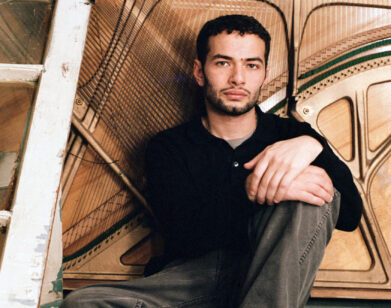Chris Burden Invades The New Museum
The beginning of artist Chris Burden’s career survey “Extreme Measures,” on view at the New Museum, is relatively gentle. Four binders, filled with grainy images and blunt statements on the artist’s brutal performance art from his early career in the 1970s, rest on desks outside of the elevators on the fifth floor. The pictures shock a bit, easing visitors towards what’s to come. Steps away is an empty room where a 2012 BBC interview can be heard in which Burden describes his infamous Shoot (1971). In the piece, the artist gets shot in front of a dozen people at the F Space Gallery in California. “Being shot is as American as apple pie,” Burden reflects nonchalantly. Then recording of the gunshot is played. The interview gets more visceral: “It went through fatty tissue. It didn’t do any damage. I had a hole in my arm, a smoking hole, which was very disgusting,” he recounts.
Next there’s an almost 40-minute video documenting Burden’s grunts, shouts, and thrashing as he nearly catches fire, crawls naked through broken glass, and kayaks out into the Pacific Ocean, en route to an uninhabited beach in Mexico where he will spend 11 days without food. Burden gave a total of nearly 60 performances over seven years. Each was enacted only once, and often documented with only one image. Watching the film for a few minutes, a feeling arises of total immersion in Burden’s sense-assaulting and intensely awesome world, filtering through the whole museum.
A video on the third floor titled Beam Drop (1984) signals Burden’s transition to sculpture. Sixty enormous steel L-beams fall a dizzying 100 to 120 feet from a crane into a foundation of wet cement. They stick up like awkward, hostile pillars, clanging as they crowd together in a bulky clump. “Using chance as an integral element in art-making has historical precedence in the works of such renowned artists as Jackson Pollock, Marcel Duchamp, and John Cage,” wrote Burden in a statement on the piece. “However, most artists of monumental steel sculpture have not embraced randomness as the essential component of their work.” The Big Wheel (1979) offers a tangible show of Burden’s fascination with heavy equipment: as a stationary motorcycle is revved up, the back tire turns a six-thousand-pound-cast-iron flywheel at 200 revolutions per minute.
The third floor houses Triple 21 Foot Truss Bridge (2013), highlighting Burden’s engineering interests. Situated between the third and fourth floor is Tower of Power (1985), a tower of real gold bricks surrounded by matchstick figures. Only one person may view the work at a time. A Tale of Two Cities (1981) and All the Submarines of the United States of America (1987) depart from massive shapes and dissolve in details: Submarines comprises 625 tiny cardboard submarines suspended on strings, the amount owned by the United States Navy. The museum equips onlookers with binoculars for A Tale of Two Cities, an expansive, sand-covered miniature panorama of a large city-state at war with a smaller one.
Leaving the show feels like a weight has been lifted—and with some distance from the colossuses of metal and brawn, it’s a reasonable impression to have. But there’s a sense of danger that sticks. And that is quite exhilarating.
“CHRIS BURDEN: EXTREME MEASURES” IS ON VIEW AT THE NEW MUSEUM THROUGH JANUARY 12, 2014.







